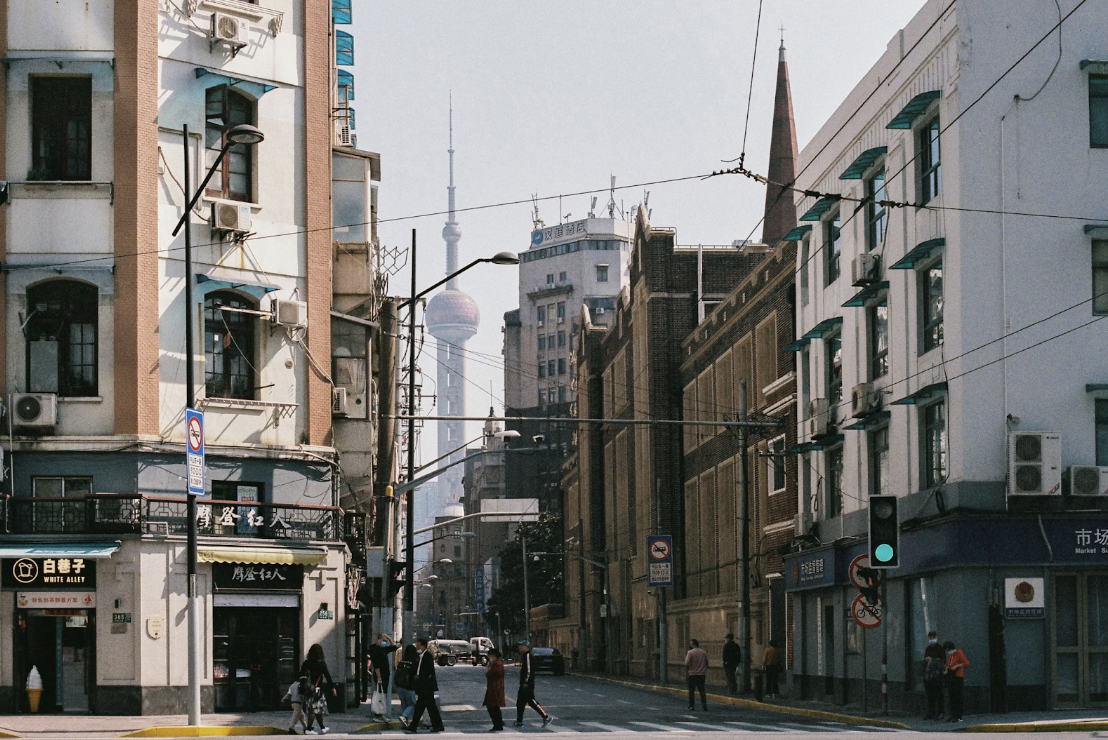Between pages of Borges and Didion and Pamuk, I’ve always believed that one must be fixed to their homeland to write about it. Someone who has watched their city change alongside them, who finds themselves coming back to the streets they grew up on. Only in this way can a city be theirs.
But my early memories of Shanghai are limited to my grandparents’ stories and photographs. I moved away in 2012, and have only visited three times since — each time, the city looking different from what I’d remembered. I have no close friends there. My favorite bakeries and stores have closed down. From a young age, I knew that being Shanghainese was something greater than myself; still, it was something to be proud of.
By my own definition, I’m not sure I have the right to write about Shanghai in the way my favorite writers do. For them, “home” usually refers to a quiet, intimate place, maybe in the suburbs of the narrator’s motherland. It evokes images of greenery and animals and unpaved streets. Shanghai, on the other hand, is not the kind of place people move away from; it’s the city they move to.
Out of 24 million residents, over 40% hail from elsewhere. Some would say Shanghai’s heartbeat is faster than London, and it sleeps even less than New York. Aside from my family, most conversations about the city circulate around its development: job opportunities, soaring rent prices, and even pollution. For many who immigrated from another country or within China, Shanghai and “home” have transformed into two separate worlds.
In a few years’ time, one search on news sites or social media began to yield countless results about COVID-19, mass production, authoritarianism, and other shades of the same Chinese stereotype. The same conversations became uncomfortable. The city’s busiest districts slowed down and were unusually underpopulated. My video chats with my grandparents continued, but now, I was an outsider.
The Decline of Shanghainese
The Chinese language is not a monolith. Standard Mandarin, the most common and frequently used by over 836 million speakers, is the country’s official language and what most deem “Chinese” to be.
In reality, there are hundreds of varieties of the Chinese language — broken into eight main groups. The exact number is unclear; the Chinese government only supports Mandarin and does not recognize many rarer dialects. Shanghainese falls into the Wu family, which has its own pronunciation, vocabulary, and tone. It is often known to have a softer sound that renders it closer to Japanese, with words “melting” into each other (listen to an example here!).
The diffusion of language is largely owed to geographical and technological differences, said Bing Qiu, a Chinese teacher and Assistant Principal of the World Languages Department at Bronx Science. Throughout history, because people across China communicated via letters and literature, language was primarily written. This, in turn, allowed different regions to develop their own pronunciations and dialects of Chinese. On the other hand, in Spanish-speaking countries, the effects of colonialism meant that pronunciation was more standardized and unified: someone from Latin America could most likely understand someone from Spain even with differences in vocabulary and tone, whereas to a Cantonese speaker, Shanghainese is mutually unintelligible.
Starting in the early 20th century, Standard Mandarin became the national language, or what is commonly known as “Chinese” in casual conversations today. With this change, the Chinese government aimed to simplify communication and establish a common tongue for people from different regions. Putting it into practice, however, was more difficult, and required strict regulation: Shanghainese, for one, was banned in schools. Even teachers, who were Shanghainese themselves, prohibited their students from speaking in their own dialect.

Without different dialects, a language becomes homogenized and robs local communities of a key part of their culture. Not only does a dialect serve as a means of communication and identity, but its usage can provide insight into the power relationships and cultural values of different societies. On a broader scale, anthropologists can use dialects as a lens into migration patterns, social networks, and linguistic shifts over generations.
“Why must our children speak (Mandarin) Chinese?” said Shanghai comedian Zhou Libo in an AFP article. “Shanghai people who cannot speak the Shanghai dialect. What stupidity!”
At the same time, Shanghainese can be exclusionary. Like with any dialect (or even accent), research has shown that people tend to think positively of those who share their own, which enables them to build group solidarity. When interacting with those who speak differently, they are more likely to think negatively and shut the non-native speaker out.
“I grew up in a more suburban area of Shanghai, where we had a separate dialect with its own subtle differences,” said Mr. Qiu. “Whenever I’d go to the city center, it often felt as though the ability to speak Shanghainese was a mechanism of social status.”
Now, rising migration means that even without government regulation, Mandarin is on an irreversible trend to become the mainstream. It seems to be the only option in a globalizing world, for convenience and inclusivity, but it signals that Shanghainese is on its own trend as well — irreversibly disappearing.
Is Shanghai Tired?
In a world where the Chinese work ethic is defined by diligence and an ingrained respect for authority, more and more young people are rejecting these societal and familial pressures. This lifestyle change has culminated in a new movement: 躺平 (tǎng píng), or “lying flat.”
China is undergoing a massive demographic shift — which many would instead label as a crisis. With nearly a quarter of the population aged 65 or older, the Chinese economy has struggled to accommodate their old people: from a weakening workforce to a shrinking elderly pension fund, the country’s sons and daughters have stepped in to fill the gap instead.
This sense of duty is known as filial piety, a traditional Chinese value stretching back to Confucianism. While it is a central tenet of family culture, it has also placed a greater burden on younger generations to take care of an older generation that is increasingly outnumbering them. In fact, a 2019 NIH study found that filial piety relies on the deference to hierarchy, which can suppress the self-autonomy and creativity of children. Although the most traditional filial standards (typically associated with patriarchy) have faded with modernization and newer progressive beliefs, obedience and submission are still systemized in Chinese society.
In addition to household pressure, Shanghai’s position as China’s largest metropolis means that working culture can turn toxic. Until 2021, the shrinking labor force translated into the “996” work schedule — the concept of employees working from 9:00 a.m. to 9:00 p.m., six days a week — being normalized and even endorsed by technology companies and their top tycoons. This policy was ruled illegal, although it is not completely abolished; given the high rates of migration and competition for jobs, many will accept brutal working conditions for a livable wage.
Exhausted by the education system and job market, many young people have decided to no longer subject themselves to relentless work. Tangping, for them, is a break from burnout and a desire to extend the slow-paced life from the COVID-19 pandemic. Since the return to the workplace in 2022, the movement has taken social media by storm.
“They literally just want to lie down with a book, or sit and watch some TV, rather than keep the momentum going by working hard,” said Kerry Allen, a Chinese media analyst, in a BBC article.
But tangping remains uniquely situated in the young generation: authority figures and older people have expressed their disdain for the social and economic risks of lying flat, particularly with the belief that a spreading “doomsday culture” can stain the traditional Chinese work ethic. As a result, the #TangPing hashtag has been banned from Sina Weibo, a prominent Chinese microblogging platform, limiting the movement’s reach.
This is only one example of the strong digital censorship across the country. China’s internet infrastructure is referred to by many as the “Great Firewall,” effectively closing off the population to many American websites and apps. Without a VPN, or Virtual Private Network, those residing in China cannot access media such as Google, Facebook, TikTok, and more. Outside of censoring politically sensitive speech, the Chinese government attempts to bar foreign influence on its citizens. While this often encompasses political speech, it can also include anything that can “disrupt the social order” or contribute to “spiritual pollution.” In 2020, the Chinese government blocked over 300,000 domains.
As more and more people are flocking to Shanghai in search of better futures, many are leaving as well. “The government has turned China around and around until, like spinning cars, people’s engines have stalled and their wheels have locked up,” noted writer Gish Jen in the The New York Times. True to her essay’s name, China’s most can-do city is indeed tired.
In the past two years, more than 310,000 people left the country annually — a 62% increase compared to the previous decade. Shanghai may hold a modern, futuristic image in the eyes of the world, but many have grown disillusioned with the city they call home.
Every time I returned home in the past, no matter how different it looked, it still felt familiar. I have a feeling that this time, in a somewhat frightening way, it will feel different too.
“The government has turned China around and around until, like spinning cars, people’s engines have stalled and their wheels have locked up,” noted writer Gish Jen in The New York Times.

